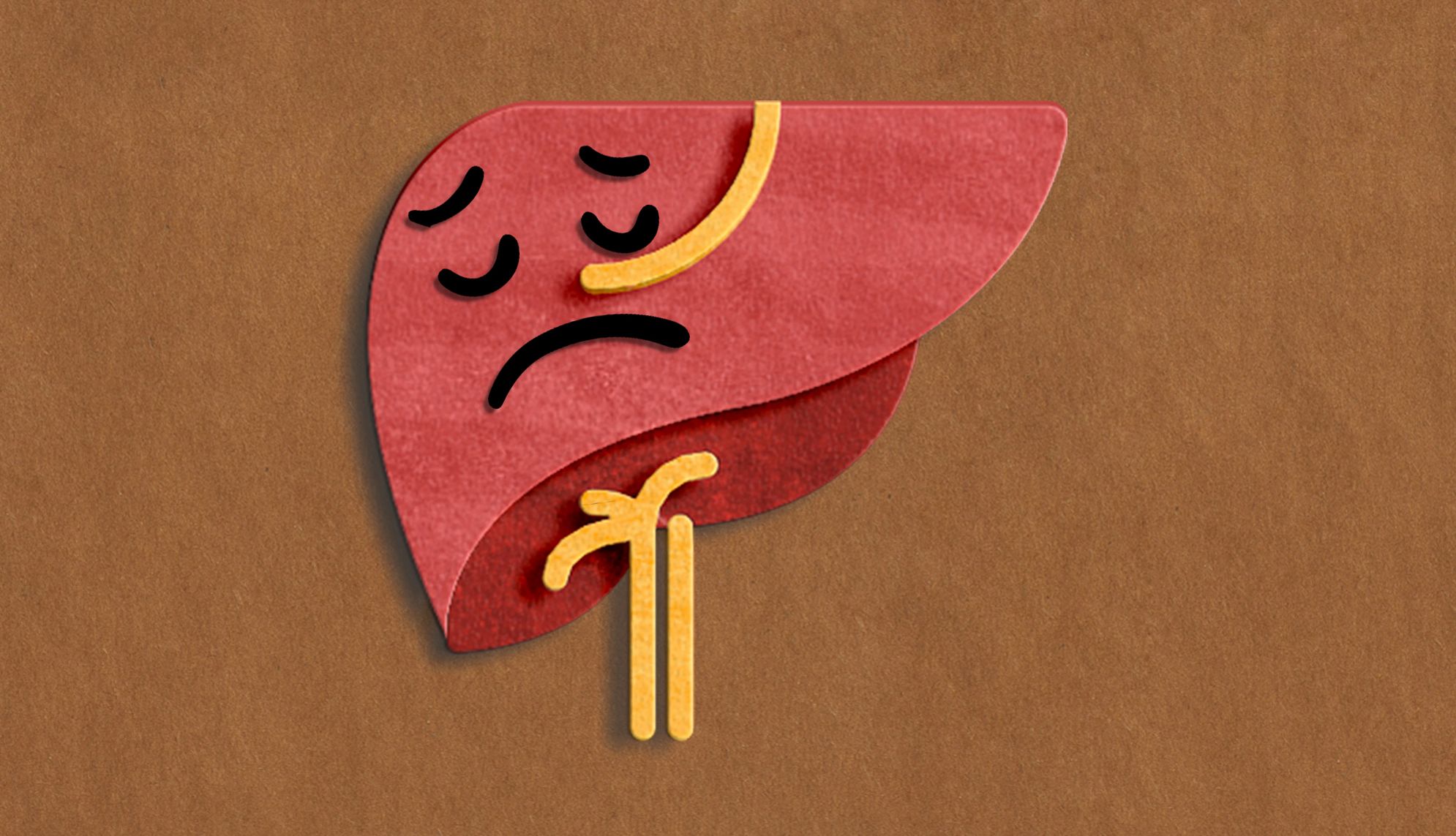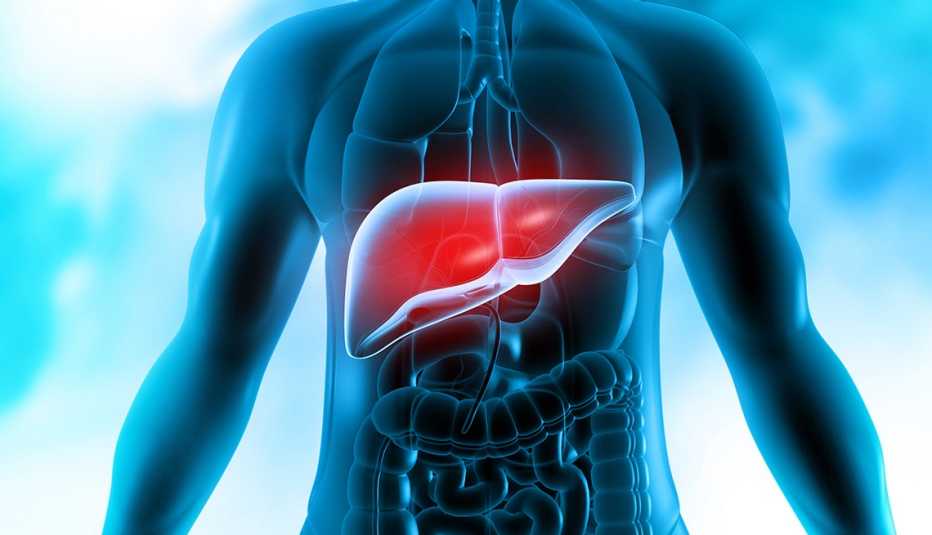Risk No. 1: Alcohol intake
We all know that alcohol can be hard on your liver. But how much is too much?
Maheshwari notes that a safe alcohol limit may seem surprisingly low: no more than one alcoholic beverage a day (or seven drinks in a one-week period) for women and two or fewer drinks for men (or 14 drinks over a week’s time).
“When patients drink alcohol in excess, beyond the capacity of the liver to metabolize it, the excess alcohol is turned into fat and stored,” Maheshwari says. “Called steatosis, this fat interferes with the liver’s function and causes cell death.”
The good news? Putting the brakes on alcohol consumption can stop the progression of fibrosis, and liver function may improve. “But it depends on when it was caught,” says Wakim-Fleming. “A lot of people who have alcoholic liver disease end up needing liver transplants because they don’t stop drinking until [too] late.”
If you suspect you may have a problem, talk to your doctor, who may refer you to a specialist for evaluation and tests.
Risk No. 2: Weight
With obesity rates on the rise in the U.S., there’s been — along with an alarming increase in diabetes and other metabolic ills — a growing epidemic of nonalcoholic fatty liver disease (NAFLD), which occurs when too much fat is stored in the liver.
“Obesity, diabetes, high blood pressure, high cholesterol — common features of metabolic syndrome — are all known major risk factors for the development of fatty liver disease,” says Craig Lammert, M.D., associate professor of medicine at the Indiana University School of Medicine and a practicing gastroenterologist and hepatologist at IU Health. As with alcohol-related liver damage, these conditions cause fat to be deposited in the liver.
“The scary piece of this is, anywhere from 15 to 50 percent of the nation’s population may have too much fat in the liver,” says Lammert. Of those, he says, about 5 percent are at risk of inflammation that can damage the liver. “But we don’t always know who that’s going to be.”
Inflammation hurts the liver by way of a condition known as nonalcoholic steatohepatitis (NASH), which damages and kills liver cells. “We’re hearing a lot about this because over the next few years, fatty liver disease will probably be near the top, if not the top, cause for liver transplantation in this country,” Lammert notes.
If you’re carrying around excess pounds or battling diabetes, high cholesterol or high blood pressure, the risk of liver failure just adds another good reason to shed some weight and get your blood sugar, cholesterol and blood pressure under control. Although there is no cure for NAFLD, it can be reversed.
Diet, exercise can reverse liver damage
A new study published in the Journal of Hepatology found that diet and exercise are an effective way to treat and improve liver disease that’s often associated with excess weight.
Researchers at the University of Missouri School of Medicine divided 24 patients with a type of liver disease caused by excessive fat buildup into two groups. One followed an intensive diet and exercise program for 10 months; the other followed the standard of care treatment. The diet and exercise group saw “significant and clinically meaningful” effects on their liver health, the researchers discovered with imaging and diagnostic biopsies.
“Obesity and diabetes are going up in the country, and they are the two main risk factors for fatty liver disease,” said study author Elizabeth Parks, a professor of nutrition and exercise physiology at the University of Missouri School of Medicine. “We know diet and exercise can alleviate these health conditions. Liver disease is increasing too fast. We were able to show in our research how diet and exercise should be the mainstay of treatment for the disease.”
Risk No. 3: Drugs and supplements
Certain drugs and supplements can also injure your liver, depending on the dose and other factors. Taking too much acetaminophen (Tylenol) is the most common over-the-counter risk. “People who overdose with Tylenol overwhelm the metabolizing system and drive liver toxicity,” Lammert says.
But patients should have few problems if they take the pain reliever as prescribed, which includes consuming no more than 4,000 milligrams in a day. Those with existing liver disease may be advised to take less than 2,000 milligrams. One caveat: If you’re taking acetaminophen at those levels, be sure to avoid alcohol, which would add to the cumulative burden on the liver, Lammert advises. Other painkillers, including NSAIDs like ibuprofen (Motrin) and naproxen (Aleve), can be similarly harmful under the same circumstances.
If you are taking anything approaching the maximum dose of acetaminophen, be aware that the drug is often found in other products, such as multi-symptom cold and flu formulations, making it easy to unwittingly double the amount you are taking. So be sure to check product labels for acetaminophen.
Surprisingly, “antibiotics are probably the most important cause of liver injury we see,” Lammert says. This is particularly true of Augmentin (a combination of amoxicillin and clavulanate), which is used to treat common bacterial problems like sinus and urinary tract infections. Liver complications affect an estimated 30,000 people a year taking this compound in the U.S. And although most of the harm is temporary, some is so damaging as to require a liver transplant.
There are also reports of liver damage with certain supplements, including bodybuilding and weight-loss supplements that contain green tea extract, linoleic acid and androgenic anabolic steroids. Even two essential nutrients, vitamin A and niacin, can harm the liver if taken above the recommended doses.
Risk No. 4: Viral infections
Hepatitis B and C are viral infections of the liver that can lead to liver damage and even cancer. (The vast majority of people with hepatitis A recover with no lasting harm.) As with other liver diseases, people with hepatitis often don’t have symptoms and may not know they are infected, Wakim-Fleming says.
People contract hepatitis B (HBV) through blood, semen and other body fluids and by sharing personal items (needles, razors) with someone who has the infection. Hepatitis C (HCV) is contracted through contact with the blood of someone with HCV, often through the sharing of drug paraphernalia or through a transfusion of contaminated blood or organ transplant prior to 1992, when blood started to be screened for the virus. More than half of people with HCV develop a chronic infection, and up to 25 percent develop cirrhosis over 10 to 20 years, according to the Centers for Disease Control and Prevention.
Vaccines are available for HBV, and everyone ages 18 to 79 should get an HCV test at least once, particularly those born between 1945 and 1965. “The guidelines over the past 10 years or so are that all baby boomers should be screened for hepatitis C,” Lammert says. Despite this recommendation, too few people who are eligible seek testing. “The good news is we now have good treatments to eradicate the disease.”
Risk No. 5: Genetics and autoimmune conditions
Genetic conditions like hemochromatosis and Wilson’s disease can contribute to the development of liver disease. In these conditions, excess metals can build up in the liver, causing cirrhosis and organ toxicity.
Additionally, autoimmune conditions may lead to liver disease and, to some extent, genetics may play a role as well. The exact cause of autoimmune liver disease is not fully understood by doctors; however, it is theorized that factors such as infection, medication or chemical exposure could act as triggers. While there may be a genetic predisposition, the specific role of genetics in causing autoimmune diseases remains unclear. Treatment for autoimmune liver disease typically involves long-term management, and while the majority of patients respond well to treatment, they often require lifelong medication.








































































More on Health
Drinking Among Older Adults Split During Pandemic
A new survey reveals a divide between drinkers and abstainers9 Signs You May Have a Drinking Problem
Ask yourself these questions about your alcohol use8 Superfoods for Your Immune System
Add these protective powerhouses to your diet to get ready for cold and flu season … and beyond